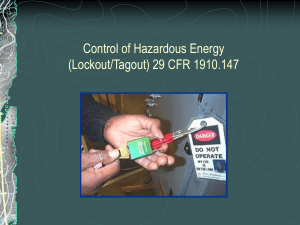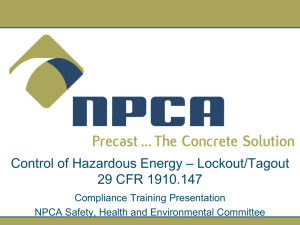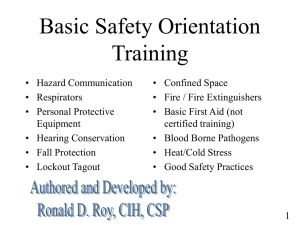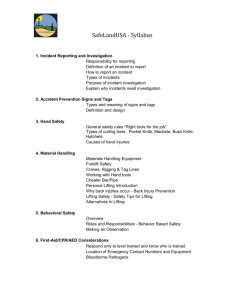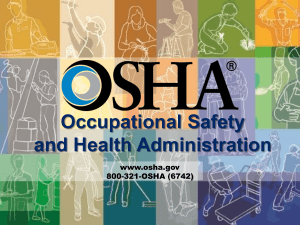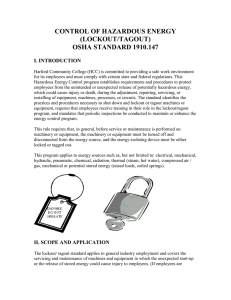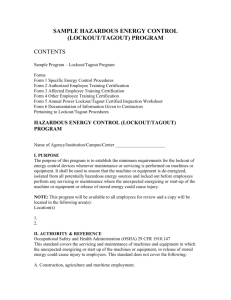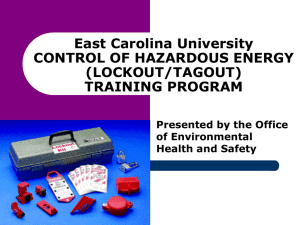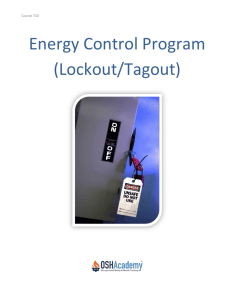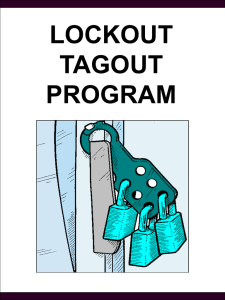P5 Lockout Tagout Procedures
advertisement
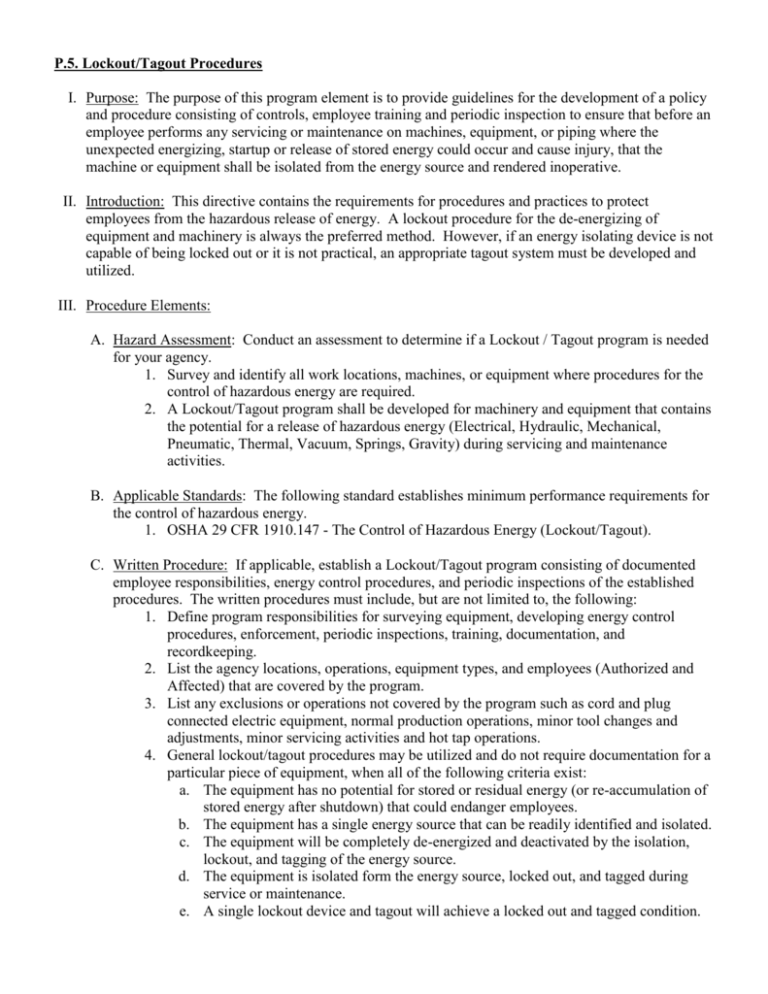
P.5. Lockout/Tagout Procedures I. Purpose: The purpose of this program element is to provide guidelines for the development of a policy and procedure consisting of controls, employee training and periodic inspection to ensure that before an employee performs any servicing or maintenance on machines, equipment, or piping where the unexpected energizing, startup or release of stored energy could occur and cause injury, that the machine or equipment shall be isolated from the energy source and rendered inoperative. II. Introduction: This directive contains the requirements for procedures and practices to protect employees from the hazardous release of energy. A lockout procedure for the de-energizing of equipment and machinery is always the preferred method. However, if an energy isolating device is not capable of being locked out or it is not practical, an appropriate tagout system must be developed and utilized. III. Procedure Elements: A. Hazard Assessment: Conduct an assessment to determine if a Lockout / Tagout program is needed for your agency. 1. Survey and identify all work locations, machines, or equipment where procedures for the control of hazardous energy are required. 2. A Lockout/Tagout program shall be developed for machinery and equipment that contains the potential for a release of hazardous energy (Electrical, Hydraulic, Mechanical, Pneumatic, Thermal, Vacuum, Springs, Gravity) during servicing and maintenance activities. B. Applicable Standards: The following standard establishes minimum performance requirements for the control of hazardous energy. 1. OSHA 29 CFR 1910.147 - The Control of Hazardous Energy (Lockout/Tagout). C. Written Procedure: If applicable, establish a Lockout/Tagout program consisting of documented employee responsibilities, energy control procedures, and periodic inspections of the established procedures. The written procedures must include, but are not limited to, the following: 1. Define program responsibilities for surveying equipment, developing energy control procedures, enforcement, periodic inspections, training, documentation, and recordkeeping. 2. List the agency locations, operations, equipment types, and employees (Authorized and Affected) that are covered by the program. 3. List any exclusions or operations not covered by the program such as cord and plug connected electric equipment, normal production operations, minor tool changes and adjustments, minor servicing activities and hot tap operations. 4. General lockout/tagout procedures may be utilized and do not require documentation for a particular piece of equipment, when all of the following criteria exist: a. The equipment has no potential for stored or residual energy (or re-accumulation of stored energy after shutdown) that could endanger employees. b. The equipment has a single energy source that can be readily identified and isolated. c. The equipment will be completely de-energized and deactivated by the isolation, lockout, and tagging of the energy source. d. The equipment is isolated form the energy source, locked out, and tagged during service or maintenance. e. A single lockout device and tagout will achieve a locked out and tagged condition. f. The lockout device is under the exclusive control of the authorized employee performing the servicing or maintenance. g. Service or maintenance of the equipment does not create hazards for other personnel. h. The equipment has no record of incidents involving unexpected activation or reenergization during service or maintenance. 4. Develop, document, and utilize equipment specific lockout and tagout procedures before work begins. The procedures must clearly and specifically outline the scope, purpose, authorization, rules, and techniques to be utilized for the control of hazardous energy. a. Employee notification procedures. b. A specific statement on how the procedure will be used. c. Specific procedural steps needed to shut down, isolate, block, and secure machines or equipment to control hazardous energy. The procedures shall cover the following elements and actions and shall be done in the following sequence: i. Preparing for shutdown. ii. Shutting down the machine(s) or equipment. iii. Isolating the machine or equipment from the energy source(s). iv. Applying the lockout or tagout device(s) to the energy-isolating device(s). v. Safety releasing all potentially hazardous stored or residual energy. vi. Verifying the isolation of the machine(s) or equipment prior to the start of service or maintenance work. d. Specific procedural steps for the safe placement, removal and transfer of lockout/tagout devices and who has the responsibility for them. i. Before lockout/tagout devices are removed and energy is restored, the following steps must be taken by the authorized employee(s): 1) Ensure that non-essential items have been removed from the work area and that machine or equipment components are operationally intact. 2) Ensure that all employees have been safely positioned or removed. 3) Notify affected employees immediately after removing locks or tags and before starting equipment or machines. 4) Make sure that locks or tags are removed by the appropriate employees, preferably only those who attached them. e. Specific requirements for testing machines or equipment to determine and verify the effectiveness of locks, tags, and other energy control measures. f. The procedures and means to enforce compliance with the requirements. 6. Develop additional safety requirements and procedures as necessary to cover the following circumstances: a. Testing or positioning of machines during servicing. b. Outside personnel (contractors) at the worksite. c. Servicing or maintenance is performed by a group d. Shift or personnel changes occur during servicing or maintenance. 7. Establish requirements for energy-isolating (lockout/tagout) devices. a. List the types of LO/TO devices (Locks, tags, chains, wedges, key blocks, adapter pins, self-locking fasteners, or other hardware) used under the policy and ensure they meet the following requirements: i. Provided by the employer. ii. Must be singularly identified. iii. Must be the only devices for controlling hazardous energy. iv. Must not be used for other purposes. v. Must be durable and capable of withstanding the environment. vi. Must be standardized within the facility. vii. Must be substantial enough to prevent removal without the use of excessive force or unusual techniques. viii. Must be identifiable by listing the name of the employee applying the device(s). 8. Establish requirements for the periodic inspections of the established lockout/tagout procedures. a. Conduct a periodic inspection of the energy control procedure at least annually to ensure the requirements are being followed and any identified inadequacies are corrected. b. The periodic inspection shall include a review of the authorized and affected (when tagouts are used) employee’s responsibilities. c. Certify and document that periodic inspections have been performed. 9. Establish procedures for outside personnel (contractors, etc.) when engaged in activities covered by the scope and application of this standard. a. The agency and the outside employer shall inform each other of their respective lockout/tagout procedures. b. The agency shall ensure affected employees understand and comply with restrictions and prohibitions of the outside employer's energy control program. D. Training: Develop procedures for the initial training and retraining of all authorized and affected employees to ensure they understand the purpose, function, and restrictions of the program. 1. Ensure authorized employees (employees trained to apply the lock or tag to the equipment being serviced or maintained) receive the knowledge and skills necessary for the safe application, usage, and removal of the energy controls to include the following: a. Recognition of the hazardous energy sources. b. The type and magnitude of the energy available in the workplace. c. The methods and means necessary for energy isolation and control. 2. Ensure affected employees (an employee whose job requires him/her to use or work in an area in which such servicing or maintenance is being performed) receive training on the energy control procedure and rules prohibiting the restarting of locked or tagged equipment. 3. When tagout systems are used, employees shall also be trained in the limitations of tags. 4. Retraining shall be provided for all authorized/affected employees whenever a periodic inspection reveals inadequacies or there are changes in the work environment, job assignments, or energy control procedures. 5. Document that initial and ongoing employee training has been accomplished. E. Checklists and Forms: Develop the necessary forms to ensure compliance with the requirements of this standard operating procedure. The forms may include, but are not limited to, the following: 1. List of equipment requiring hazardous energy control procedures (HECP). 2. Lockout/Tagout Procedure Self-Assessment Checklist. 3. Lockout/Tagout Log. 4. Emergency Lockout/Tagout Device Removal Checklist. 5. Equipment Specific Lockout/Tagout Procedure. F. Program Effectiveness Review and Response: The effectiveness of this program in preventing workplace hazards, injuries, and illnesses should be evaluated at least annually with appropriate actions taken including the documenting of annual reviews.
